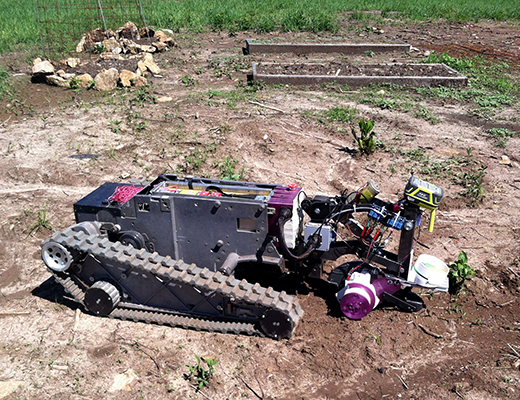USDA-funded multi-robot farming project to aid in increasing world's food supply
Thursday, Jan. 11, 2018

Use of robotic farming on highly sloped land is the focus of a nearly $1.2 million project led by Kansas State University's Dan Flippo. | Download this photo.
MANHATTAN — The world will be required to feed an estimated 9 billion people by 2050, but annual percentage crop yield increases are currently only half those required to meet these projected food needs. This pressing issue is being taken on by a team of researchers at Kansas State University whose aim is to increase arable land acreage considered too steep for use with conventional equipment.
Enter the robots.
"Multi-Robot Farming on Marginal, Highly Sloped Lands" is a three-year, $1,178,191 grant project from theU.S. Department of Agriculture's National Robotics Initiative 2.0: Ubiquitous Collaborative Robots, headed by Dan Flippo, assistant professor in the biological and agricultural engineering department.
This project will explore use of multiple small robots to farm highly sloped land. The robots, the size of a common wheelchair, will work in groups to accomplish fieldwork by unconventional means. Strap-on hardware modules will be designed to allow the small vehicles to plant, manage and harvest wheat on hills with slopes as great as 55 percent, or 30 degrees.
Joining Flippo in the endeavor at Kansas State University are Stephen Welch, professor, and Antonio Asebedo, assistant professor, both in agronomy; Arnaud Temme, associate professor of geography; and Sanjoy Das, associate professor of electrical and computer engineering.
"The outcome will be a total agriculture farming system melding unmanned aerial flyovers of the field and robotic planting-management-harvest systems to provide the extra yield needed to meet the 2050 dilemma," Flippo said. "The system will be scalable, configurable and foreshadow the future of agricultural automation."
The small autonomous vehicle farming concept is brand-new, allowing engineers and scientists to rethink cropping operations. It has the potential of not only increasing yield for an enlarging population but to do so in a sustainable way that will allow continued feeding of the world.
An intensive geographic analysis has shown an additional 4 percent of the Great Plains could be brought into production using this farming technology. Though a seemingly small increase, the area is a global power in wheat production and currently hits those production rates on not quite 7 percent of its land.
"This new approach and the research that must accompany it have the potential to help Kansas State University meet and exceed its 2025 goals by placing us at the forefront of small autonomous vehicle agriculture," Flippo said.

